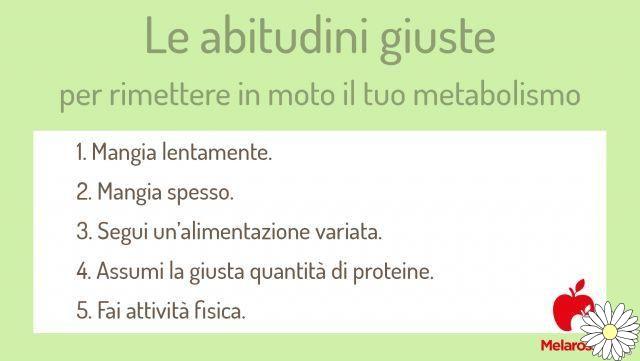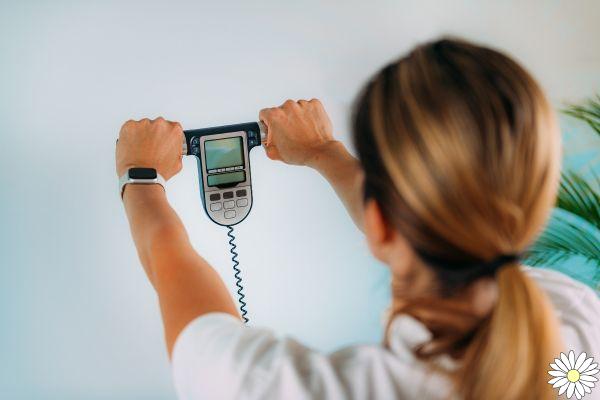When you are on a diet or are you going to lose weight, it is inevitable to arrive at also think about the functioning of the metabolism. How to speed up the metabolism? This process deals with satisfying energy demands, through extraction and the use of energy contained in the foods you eat.
In the body, there is a dynamic balance between anabolic reactions (of construction) e cataboliche (of destruction). This allows us to modulate food intake. In this way, a balance is created between revenues (food) and outings (energy expenditure) which can be positive or negative as needed.
Find out about the foods that speed up your metabolism and why a slow metabolism, which does not work well, makes the weight loss much more difficult.
Being overweight, and more have little lean mass, determine a low basal metabolic rate, if we add sedentary lifestyle and low physical activity, this will further worsen the picture.
In fact, only increasing muscle mass, you can feel better, more active, dynamic and with a "reactivated" metabolism.
Metabolism: definition and meaning
In Greek metabolé means "change".
The metabolism of a substance is simply there chemical transformation of the same in something else. Thus, if at the cellular level, sugar is transformed into energy, we can say that a "metabolism" takes place. Cell metabolism, to be precise.
The metabolism is therefore the set of chemical reactions that take place in your body - and the hormonal regulation of these reactions - for transform ingested food in the energy needed by the cells of your body. An energy that is used by the body to make cells function properly and to keep us alive.
The body is an open system that interacts with the external environment by exchanging matter and energy. This energy is stored by our body in the form of chemical bonds following food intake.
We are used to seeing a food as a food, but our body "thinks" in terms of nutrients, ie proteins, carbohydrates and fats.
These can be oxidized for energy (in the form of heat) or, if there is no need (perhaps when the intake is excessive), they are stored in the form of triglycerides (fats).
The metabolism of a subject is given by the sum of basal metabolism, dieto-induced thermogenesis (i.e. the energy developed in the digestive processes) and physical activity.

Basal metabolism
When it comes to BMR, it refers to what your body consumes in resting conditions absolute.
To be more precise, the basal metabolism represents that minimum amount of energy necessary for the awake person, but in a total state of rest, to maintain their vital functions (breathing, circulation, digestion, etc.). It usually comes calculated after fasting for at least 12 hours and in a moment of physical and psychological relaxation.
This energy expenditure which, in a healthy and sedentary adult, represents about 65-75% of the total, is mainly attributable to the activity of the lean mass, that is, to the muscles and internal organs, especially the brain, liver, kidney and heart.
Normally in men, la lean mass is greater compared to women, while for all, there is one of its own progressive reduction over the years. Also, there is one great variability from one person to another.
This means that with the same calories introduced, someone can tend to gain more weight than another.
How to calculate the basal metabolic rate
Basal metabolism is expressed with the calories required to carry out vital and physiological functions:
- Growth.
- Development.
- Maintenance of heart rate and body temperature.
- Breathing, etc.
But how do we calculate the basal metabolic rate (MB)?
There are several mathematical formulas, but the most used is that of Harris-Benedict, which differs for males and females:
- Our girls: 655,095 + (9,563 x weight) + (1,8496 x height) - (4,6756 x age).
- Males: 66,473 + (13,7516 x weight) + (5,0033 x height) - (6,755 x age).
Reading the equations carefully, we understand how the variables that influence the basal metabolism are:
- Sex.
- Age (MB is maximum at birth and decreases to a minimum after age 70).
- Stature.
- Weight.
However, there are also other parameters that come into play: pathological states such as hyper- or hypothyroidism are able to modulate the metabolism following an altered production of thyroid hormones. But also normal physiological alterations (pregnancy or breastfeeding) tend to increase energy expenditure.
Thus, about 20% of the basal metabolism is represented by skeletal muscles, that is, from those muscles that are "trainable", consequently a increase in muscle mass it is the only physiological way to increase resting metabolism.

Energy metabolism
It is determined by thephysical activity that you do every day and from food induced thermogenesis.
So, from the work you do to move the body, make different movements or lift a weight and the energy consumption needed to digestion, absorption and metabolism of the food consumed.
It always represents one percentage of energy consumption lower compared to that of the basal metabolic rate, unless this is increased with a 'very intense sporting activity.
In addition, it should be considered that every physical activity has a particular energy cost, which affects yours differently daily calorie requirement.
The evaluation of energy metabolism it must be done bearing in mind some factors, such as:
- Intrinsic energy cost of the activity.
- Time needed to carry out the activity.
- Size of the individual carrying out the activity.
The energy consumption for the same activity becomes higher the greater the intensity, speed and time of its execution.
How does the energy metabolism work?
There is a link between exercise intensity and consumption of fats or carbohydrates (sugars).
The main factors that determine what will be used by the muscles during exercise are:
- Exercise type: for example if it is continuous or intermittent.
- Duration.
- Intensity.
- Training state.
- Diet followed.
- Physical state of the person: for example some diseases, such as diabetes, can change the use of energy.
In general, we can say that in the case of a physical activity of low intensity and short duration, the body will draw the energy it needs in equal measure from fats and carbohydrates.
When physical activity is of low intensity, but of one longer duration - at least one hour -, the body tends to burn more fat, which cover the energy demand almost 80%.
Metabolism: how it works
This set of metabolic chemical reactions takes place continuously in your body, through two essential processes:
- Catabolism.
- Anabolism.
The catabolic reactions
Catabolism is also called "destructive metabolism“, Because it consists in the breakdown of molecules introduced with food into others more easily usable by the body.
In particular, macromolecules, such as i lipids, proteins, carbohydrates (but also vitamins, i mineral salts and all other substances) are degraded to produce energy, simpler molecules, which perform other functions, or to be recycled.
The anabolic reactions
Anabolism processes these recycled parts, giving them a plastic function and of energy reserve.
In other words, the anabolism has task of growing organs and tissues, to restore them in case of destruction or for a simple replacement and to store them molecules and deposit it.
This "reserve" ensures that there is always a sufficient amount of energy, to allow us to face the efforts and to allow the cells to develop properly.
Furthermore, this reaction also has the function of preserve and optimize the energy that can serve you in the future.
What is the metabolism for?
This complex system of reactions is very important for both your health, both for the management of yours body weight.
In fact, it is basically the metabolism a I will determine the diet to follow and thephysical activity to do, For be able to reach the desired weight.
To assess the proper functioning of your metabolism, a further distinction needs to be made between that baseline (Also called BMR) and that linked to the activity carried out by the individual (energy metabolism).

How to speed up the metabolism
Basal and energy metabolism together represent the total of your energy consumption, i.e. what you actually consume during the day.
In a proper diet, this total must always be equal or, if you want to lose weight, higher than the caloric requirement introduced with food.
This is why slow metabolism is one of the challenges to be overcome for those looking to lose weight. Very often it is this ailment that you blame, if the scale needle does not go down. The solution you find most often is to cut calories a lot.
A choice that actually does nothing but slow down or even slow down block weight loss, because your body gets defensive. If you feed little, you cannot afford to consume your energy reserves and therefore your metabolism slows down.
Le low calorie diets which they tend to produce rapid weight loss they consume the fat, but also the muscles, that is lean mass, which most influences the change in basal metabolic rate.
Because of this, this fast weight loss is often followed by rapid increases as soon as you start eating again.
 Blukar Jump Rope, Speed Jump Rope ...
Blukar Jump Rope, Speed Jump Rope ... - Sturdy Steel Skipping Rope: The Blukar skipping rope is made of steel wire ...
- Easily Adjustable Rope: The length of the rope is 2,8m. You can adjust the length of the ...
- High Quality Ball Bearings: The skipping rope has integrated high quality ball bearings ...

Metabolism: how to get it back in motion
Just adopt some simple and healthy habits for speed up metabolism, starting the weight loss process correctly.
OnlyBelleza helps you find a healthy lifestyle, with some useful advice.
Eat slowly
La first digestion takes place in the mouth. In fact, if you eat too fast, you don't chew food properly, swallow air and run into digestive difficulties major.
In addition, you assimilate foods worse and you tend to swell and get fat.
Eat often
A strategy to reactivate the metabolism can be that of eat little and often. Especially to break hunger between meals, munching on vegetables that helps keep you fit, stimulating the metabolism and keeping the sense of hunger at bay.
Eat variously
It is important to learn to eat not only in terms of nutritional quality but also in terms of methods.
You have to eat everything, but in the right balance provided by the food pyramid of Mediterranean diet, correctly distributing the meals in 5 small daily portions.
Find out everything you need to know about Mediterranean diet.
The importance of proteins
Reactivating the metabolism may not be easy.
In addition to eating little and often, you can introduce a slightly increased proportion of protein (but not for prolonged periods) and above all vary your calorie intake by 300-500 calories each day.
In this way yes "Displaces" the metabolism which is more difficult to adapt to a low-calorie diet.
In addition, the intake of proteins, associated with physical activity, guarantees a growth and maintenance of lean tissues that positively influence the basal metabolism.
Do you practice any sport
Sports activity is essential for a metabolism that works, because it guarantees growth e the maintenance of tissues mainly responsible for basal metabolism.
The advice is to do a physical activity of aerobic type for 45-60 minutes consecutive 2 or 3 times a week, but be careful not to overdo it if you are not trained.

Foods that accelerate metabolism
It is not correct to rely on the choice of certain foods rather than others to speed up the metabolism, because They are few the foods that do it and in any case always in a relative way.
Among these we can mention foods rich in iodine, such as fish or shellfish, because this element helps thyroid function.
Also coffee, chocolate, green tea e guarana they can make a small contribution in accelerating metabolism. At the same time, however, a diet that is excessively rich in these foods can be counterproductive, that is, to cause effects contrary to the original goal of wanting maintain good health.
A smart choice is to consume them in balanced manner, alongside the fruit and vegetables, preferably fresh and in season. Also important choose foods that are as natural as possible e integrals and avoid, or at least reduce, those they contain refined carbohydrates, hydrogenated fats and simple sugars.
Same goes for the alcohol, which if consumed in excessive quantities could stimulate the mechanisms of fat accumulation and therefore to influence your metabolism.
Slow metabolism: what you must not do
Follow a high calorie diet, eat fast and lead a sedentary lifestyle are the most common mistakes. The strategy is unique: that of education.
Incorrect nutrition or disordered is one of the main causes of this disorder, particularly thehabit of skipping breakfast, decisive meal for a correct metabolic activation.
Even one strongly hypocaloric diet prolonged over time tends to reduce metabolic reactions.
To this is added the fasting, a way of communicating to the body that there is a shortage of food. If you do, he defends himself by lowering consumption and therefore metabolism.
Finally, not exercising is another mistake which leads to a lowering of metabolism.

Other causes
When thyroid little works (hypothyroidism), as occurs for example in areas with iodine deficiency or following a thyroiditis, metabolism can slow down.
In these situations, we always advise you to consult your doctor, before making any changes to your diet. It may be helpful to use the iodized salt instead of classic salt.
Another reason for slowing down is the changes in your body in different ones stages of life. Basal metabolic rate inadolescent age or in the young adult it represents the 70% of the basal energy expenditure, while in the elderly it may not exceed 50%. This decline is due to the loss of lean mass.
In menopause, also to cause of hormonal decline, there is a reduction in general metabolic activity.
You must therefore follow a low-calorie diet and carry out adequate physical activity. Consume foods rich in phytoestrogens, such as soy, it may be a guessed choice at this stage of life.
With the collaboration of Maria Cassano, nutritionist biologist.
SaveSave
SaveSave
You might also be interested
 What is your body fat percentage?
What is your body fat percentage? OnlyBelleza sandwich diet
OnlyBelleza sandwich diet Diet to gain weight OnlyBelleza
Diet to gain weight OnlyBelleza Swelling after lunch: the nutritionist's advice
Swelling after lunch: the nutritionist's advice The most dangerous diets for your health
The most dangerous diets for your health How to survive the extra pounds after pregnancy
How to survive the extra pounds after pregnancy Don't get fat on Christmas: 8 tips for celebrating without having to regret it
Don't get fat on Christmas: 8 tips for celebrating without having to regret it Why you get fat: the 7 causes besides food
Why you get fat: the 7 causes besides food Wrong diet? 7 signs to find out!
Wrong diet? 7 signs to find out!


























